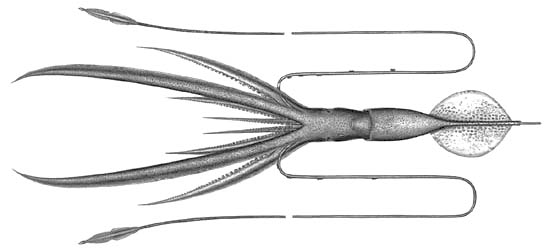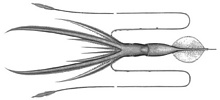Chiroteuthis joubini
Clyde F. E. Roper and Richard E. YoungIntroduction
C. joubini occurs in the tropical to subtropical waters of the Atlantic and Indian Oceans. It is separated from its closest relatives by the shortness of the proximal section of the tentacular club and by the lack of globular arm suckers.
Diagnosis
A Chiroteuthis ...
- with protective membranes of club in three sections; proximal section much shorter than others.
- with circular ocular photophores in two series.
Characteristics
- Arms
- Large arm suckers with 22-26 pointed, triangular teeth, in contact at bases, over distal 2/3 of ring.
- Largest suckers not globular.
- Tentacular clubs
- Suckers with 7-8 pointed teeth, in contact at bases, over distal 1/2 of ring; no enlarged central tooth.
- Suckers with stalks in two distinct parts; stalks of lateral suckers about equal in length to stalks of medial suckers.
- Protective membranes
- Membranes in three distinctive sets.
Figure. Aboral view of the tentacular club of C. joubini. Drawing by A. D. Hart (© C. Roper)
- Proximal set with 7-12 trabeculae (14-18% of club length).
- Middle set without distinct trabeculae but opposite 9-12 marginal suckers (32-36% of CL).
- Distal set with 20-21 trabeculae (46-54% of CL).
- Membranes in three distinctive sets.
- Photophores
- Eyeball with oval organs in 2 series: lateral series= 5 or 6 organs; 1(enlarged)+4(or 3)+1; medial series = 5 or 4+1. Formula reads from posterior to anterior.
- Viscera: two, large photophores.
- Pigmentation
- Club sucker stalks with epithelial pigment but not pleated; epithelial pigmentation diminishes then disappears in distal portions of club.
Comments
More details of the description of C. joubini can be found here.Nomenclature
This species was originally described by Joubin (1933) although he identified it as C. lacertosa. Voss (1967) recognized that Joubin's specimen did not conform to the true C. lacertosa (= C. veranyi), nor to any other described species, so he renamed it as a new species. Joubin's description becomes the type description and Joubin's specimen is the holotype of C. joubini.
Distribution
The type locality is the tropical North Atlantic at 8°N, 44°W. This species is known from the temperate north to temperate south Atlantic Ocean.
References
Joubin, L. 1933. Notes preliminaries sur les Cephalopodes des croisieres du Dana (1921-1922). 4e Partie. Ann. Inst. Oceanogr., new series, 13(1): 1-49.
Voss, G. L. 1967. Some bathypelagic cephalopods from South African waters. Ann. South African Mus., 50: 61-88.
About This Page

Smithsonian Institution, Washington, D. C., USA

University of Hawaii, Honolulu, HI, USA
Page copyright © 2019 and
All Rights Reserved.
Citing this page:
Roper, Clyde F. E. and Richard E. Young. 1999. Chiroteuthis joubini . Version 01 January 1999 (under construction). http://tolweb.org/Chiroteuthis_joubini/19475/1999.01.01 in The Tree of Life Web Project, http://tolweb.org/










 Go to quick links
Go to quick search
Go to navigation for this section of the ToL site
Go to detailed links for the ToL site
Go to quick links
Go to quick search
Go to navigation for this section of the ToL site
Go to detailed links for the ToL site